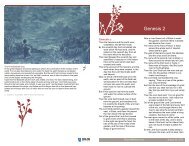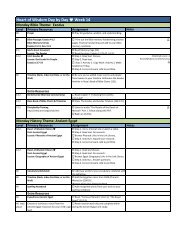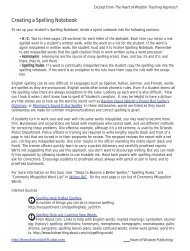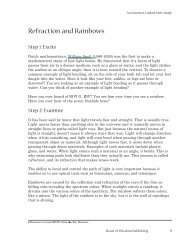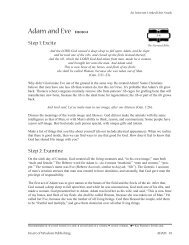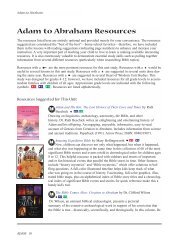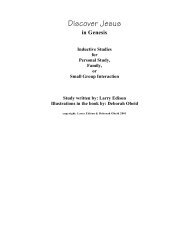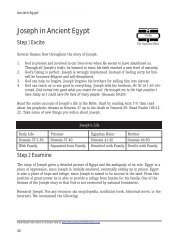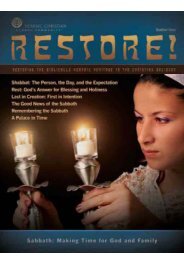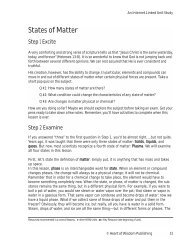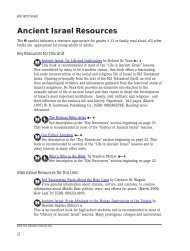Unit 3: Ancient Egypt - Heart of Wisdom
Unit 3: Ancient Egypt - Heart of Wisdom
Unit 3: Ancient Egypt - Heart of Wisdom
- No tags were found...
You also want an ePaper? Increase the reach of your titles
YUMPU automatically turns print PDFs into web optimized ePapers that Google loves.
<strong>Unit</strong> 3: <strong>Ancient</strong> <strong>Egypt</strong>The PlaguesStep 1 Excite103-110The Narrated BibleMake a list <strong>of</strong> the plagues, from memory if possible. Then read Psalm 78. Whichplagues are mentioned?Step 2 ExamineThe Lord's purpose in the 10 plagues is to reveal himself. Four players orgroups <strong>of</strong> players have the opportunity to know the Lord in the drama <strong>of</strong> theplagues: Moses, the Israelites, the <strong>Egypt</strong>ians and Pharaoh. Ultimately, theLord reveals himself by distinguishing between himself and everyone else. Thedifference between the Lord and everyone else is enhanced in the followingways, as seen in the plagues, which appear in three series <strong>of</strong> three, with the10th and final plague standing alone. 1A Family Guide to the Biblical Holidays 2 explains that each plague that God put on the<strong>Egypt</strong>ians related to an <strong>Egypt</strong>ian idol as follows:First Plague: The Nile Waters Turn to Blood—The Nile, the river <strong>of</strong> <strong>Egypt</strong>, was the<strong>Egypt</strong>ians' idol. The Nile's waters nourished the land and determined the welfare <strong>of</strong> all thepeople. The <strong>Egypt</strong>ians thirsted after blood when they slaughtered the Hebrews' children, andnow God gave them blood to drink. Thus, the source that usually brought the <strong>Egypt</strong>ians lifebrought death instead. (Exodus 7:14-25)Second Plague: The Frogs—The frogs represented the fertility goddess, Isis, which was supposedto help women in childbirth. Frogs were everywhere: in their houses, in their beds, andat their tables. They could not eat, drink, or sleep without their precious god. The frog thatsymbolized life had to be raked into heaps <strong>of</strong> rotting death. (Exodus 8:1-15)Third Plague: The Lice—The lice, which came up out <strong>of</strong> the dust <strong>of</strong> the earth, representedthe <strong>Egypt</strong>ians' god <strong>of</strong> the earth, Seth. Matthew Henry notes that lice were small, despicable,inconsiderable creatures, and yet, by their vast numbers, they rendered a sore plague to the<strong>Egypt</strong>ians. God could have plagued them with lions, bears, wolves, vultures, or other birds <strong>of</strong>prey, but He chose to do it using these minuscule but contemptible instruments. (Exodus8:16-19)Resources recommended in d several lessons, sseveral units, hother HOW <strong>Unit</strong>s. kKey Resource (see beginning <strong>of</strong> unit or page 32).<strong>Heart</strong> <strong>of</strong> <strong>Wisdom</strong> Publishing 209
<strong>Ancient</strong> History: Adam to MessiahFourth Plague: The Flies—The stinging, disease-carrying flies ruined the land. Beelzebub,the prince <strong>of</strong> the power <strong>of</strong> the air, has been glorified as the god <strong>of</strong> flies, the god <strong>of</strong> Ekron. Thefly was always present at idolatrous sacrifices. This fourth plague came upon the <strong>Egypt</strong>iansonly. It made Israel a separate and Holy People. (Exodus 8:20-32)Fifth Plague: The Disease <strong>of</strong> Livestock—A great number <strong>of</strong> cattle died by a sort <strong>of</strong> pestilence.The <strong>Egypt</strong>ians made the Hebrews poor, so God caused great loss to the <strong>Egypt</strong>ians. The<strong>Egypt</strong>ians believed that animals were possessed by the spirits <strong>of</strong> gods. The bull was sacredin <strong>Egypt</strong>, identified in its markings with their god Apis. As God's Word tells us, this diseaseafflicted only the <strong>Egypt</strong>ian livestock, not the Hebrew livestock. (Exodus 9:1-7)Sixth Plague: The Boils—Again God demonstrated His ability to control nature. When thedeath <strong>of</strong> their cattle didn't convince the <strong>Egypt</strong>ians, God sent a plague that seized their ownbodies. And they took ashes <strong>of</strong> the furnace, and stood before Pharaoh; and Moses sprinkled it uptoward heaven; and it became a boil breaking forth with blains upon man, and upon beast. (Exodus9:10) Sores in the body were looked upon as punishment for sin, a means by which to callone to repentance. None <strong>of</strong> the Hebrews had any boils. This plague was a direct attack onthe shamanism <strong>of</strong> the medico-mystical processes in <strong>Egypt</strong>. (Exodus 9:8-12)Seventh Plague: The Hailstorm—Moses gave the people a one-day warning before thisplague. The notice was given because the sorcerers <strong>of</strong> <strong>Egypt</strong> were also agricultural shamanswho supposedly controlled the weather. Those who feared the Lord took shelter (showing usthat God had mercy on some <strong>of</strong> the <strong>Egypt</strong>ians). Those who did not believe in God and took noshelter died in the fields. (Ex. 9:21) There was ice and fire mingled with the hail, very grievous,such as there was none like it in all <strong>of</strong> the land <strong>of</strong> <strong>Egypt</strong>. The hail killed both men and cattle,and battered down the herbs, vegetable gardens, fruit trees, and other plants. God, in Hisjudgment, caused it to rain and hail on the <strong>Egypt</strong>ians and not on the Hebrews. (Exodus 9:13-35)Eighth Plague: The Locusts—By this time, Pharaoh's people, his magicians, and his advisorsbegan to rebel. Pharaoh stood alone against God. Moses stretched forth his rod over the land <strong>of</strong><strong>Egypt</strong>, and the LORD brought an east wind upon the land all that day, and all that night; andwhen it was morning, the east wind brought the locusts. And the locusts went up over all the land<strong>of</strong> <strong>Egypt</strong>, and rested in all the coasts <strong>of</strong> <strong>Egypt</strong>: very grievous were they; before them there were nosuch locusts as they, neither after them shall be such. This plague devastated the land and hencethe power <strong>of</strong> the gods and shamans <strong>of</strong> agriculture. Pharaoh sent for Moses and pretended torepent. He asked Moses to pray to God to take the locusts away. And the LORD turned amighty strong west wind, which took away the locusts, and cast them into the Red Sea; thereremained not one locust in all the coasts <strong>of</strong> <strong>Egypt</strong>. (Exodus 10:13-14,19)Underlined text refers to Internet link at http://Homeschool-Books.com210
<strong>Unit</strong> 3: <strong>Ancient</strong> <strong>Egypt</strong>Ninth Plague: The Darkness—The <strong>Egypt</strong>ians rebelled against the light <strong>of</strong> God's Word andthey were justly punished with darkness. This thick darkness was over <strong>Egypt</strong> three days, butthe people <strong>of</strong> Israel had light where they dwelt. What a picture <strong>of</strong> dark and light, <strong>of</strong> beinglost and saved. The children <strong>of</strong> God walked in the light while Pharaoh and his people wanderedin the darkness. Matthew Henry's Commentary states,The cloud <strong>of</strong> locusts, which had darkened the land (v. 15), was nothing to this.It was a total darkness. We have reason to think, not only that the lights <strong>of</strong>heaven were clouded, but that all their fires and candles were put out by thedamp or clammy vapors which were the cause <strong>of</strong> this darkness; for it is said(v. 23), “They saw not one another.” It is threatened to the wicked (Job 18:5-6)that the “spark <strong>of</strong> his fire shall not shine,” even the sparks <strong>of</strong> his own kindling,as they are called (Isa. 50:11), and that the “light shall be dark in histabernacle.” Hell is utter darkness. The “light <strong>of</strong> a candle shall shine no moreat all in thee” (Rev. 18:23).This plague was an attack on the power <strong>of</strong> the supreme deity <strong>of</strong> <strong>Egypt</strong>, the sun god, Ra orAmun-Ra. The <strong>Egypt</strong>ians could do nothing but stay in their homes and consider what theyhad experienced to that point regarding the power <strong>of</strong> the God <strong>of</strong> the Israelites. Even then,Pharaoh refused to yield. (Exodus 10:21-29)Tenth Plague: The Death <strong>of</strong> the Firstborn—God said in Exodus 13:2, Sanctify unto me all thefirstborn, whatsoever openeth the womb among the children <strong>of</strong> Israel, both <strong>of</strong> man and <strong>of</strong> beast: it ismine.Nelson's Illustrated Bible Dictionary explains the importance <strong>of</strong> the firstborn:God placed a special claim on the firstborn <strong>of</strong> man and beast (Ex. 13:11-13).This meant that the nation <strong>of</strong> Israel attached unusual value to the eldest sonand assigned special privileges and responsibilities to him. Because <strong>of</strong> God'sclaim on the first <strong>of</strong>fspring, the firstborn sons <strong>of</strong> the Hebrews were presentedto the Lord when they were a month old. Since the firstborn was regarded asGod's property, it was necessary for the father to redeem, or buy back, thechild from the priest. Early Hebrew laws also provided that the firstlings <strong>of</strong>beasts belonged to the Lord and were turned over to the sanctuary (Ex. 13:2;34:19; Lev. 27:26). The firstborn's birthright was a double portion <strong>of</strong> the estateand leadership <strong>of</strong> the family. As head <strong>of</strong> the home after his father's death, theeldest son customarily cared for his mother until her death, and provided forhis unmarried sisters until their marriages. He was the family's spiritual headand served as its priest. In figurative language, the term firstborn stands forthat which is most excellent.Resources recommended in d several lessons, sseveral units, hother HOW <strong>Unit</strong>s. kKey Resource (see beginning <strong>of</strong> unit or page 32).<strong>Heart</strong> <strong>of</strong> <strong>Wisdom</strong> Publishing 211
<strong>Ancient</strong> History: Adam to MessiahThe significance <strong>of</strong> the death <strong>of</strong> every firstborn in <strong>Egypt</strong>, from the house <strong>of</strong> Pharaohto the slaves and the livestock, was great. But Israel would be spared so that therewould be an obvious distinction between those who belong to the YAWH and thosewho do not. (Exodus 11:1-10)And it came to pass, that at midnight the Lord smote all the firstborn in the land <strong>of</strong><strong>Egypt</strong>, from the firstborn <strong>of</strong> Pharaoh that sat on his throne unto the firstborn <strong>of</strong> thecaptive that was in the dungeon; and all the firstborn <strong>of</strong> cattle. And Pharaoh rose upin the night, he, and all his servants, and all the <strong>Egypt</strong>ians; and there was a greatcry in <strong>Egypt</strong>; for there was not a house where there was not one dead. And he calledfor Moses and Aaron by night, and said, Rise up, and get you forth from among mypeople, both ye and the children <strong>of</strong> Israel; and go, serve the Lord, as ye have said.Also take your flocks and your herds, as ye have said, and be gone; and bless mealso. And the <strong>Egypt</strong>ians were urgent upon the people, that they might send them out<strong>of</strong> the land in haste; for they said, We be all dead men. And the people took theirdough before it was leavened, their kneading troughs being bound up in their clothesupon their shoulders. And the children <strong>of</strong> Israel did according to the word <strong>of</strong> Moses;and they borrowed <strong>of</strong> the <strong>Egypt</strong>ians jewels <strong>of</strong> silver, and jewels <strong>of</strong> gold, and raiment:And the Lord gave the people favour in the sight <strong>of</strong> the <strong>Egypt</strong>ians, so that they lentunto them such things as they required. And they spoiled the <strong>Egypt</strong>ians. (Exodus12:29-36)Research the Plaugues. Use any resource (an encyclopedia, nonfiction book, historical novel,or the Internet). We recommend the following:BooksEncyclopedia <strong>of</strong> the Bible (Nelson’s Illustrated) hBCRead: “The Exodus from <strong>Egypt</strong>” (20-21).The Victor Journey through the Bible khBCRead: “The Plagues” (58-59).Step 3 ExpandUnderlined text refers to Internet link at http://Homeschool-Books.com212WCActivity 1: Write a Newspaper StoryWrite a newspaper story as if you are a reporter summing up the TenPlagues <strong>of</strong> Judgment on the <strong>Egypt</strong>ians. Refer to the book <strong>of</strong> Exodus: 7:14-25(plague <strong>of</strong> blood); 8:1-15 (frogs); 8:16-19 (lice); 8:20 (flies); 9:1-7 (murrain <strong>of</strong> cattle);9:8-12 (boils and sores); 9:18-34 (hail); 10:1-20 (locusts); 10:21-23 (darkness);and 11:4-7; 12:17,29 and 30 (death <strong>of</strong> the firstborn). Read Psalm 105:23-38
<strong>Unit</strong> 3: <strong>Ancient</strong> <strong>Egypt</strong>to find out how the <strong>Egypt</strong>ians felt about the Israelites. Include an imaginary interviewwith an <strong>Egypt</strong>ian, describing how he feels about the events. Refer to “Writingabout an Event” in Writers INC.Activity 2: Copy a PassageOCCopy a descriptive passage or interesting conversational passage fromthe Bible that discusses the plagues.Step 4 ExcelHave your family join you in acting out the ten plagues in a ten-day period.1. Water into blood: use red food coloring on all the water sources (drinking water, sinks,cat's bowl, etc.).2. Frogs: put paper ones everywhere around the house, including on your plates <strong>of</strong> foodand in beds.3. Lice: slap at imaginary ones and scratch “itches.”4. Flies: go through the house swatting with fly swatters, and tape pepper to windows.5. Livestock death: put stuffed animals belly-up around the house.6. Boils: draw red spots all over your body with lipstick or face paint.7. Hail: go outside and toss ice chips on each other.8. Locusts: tape paper locusts on walls, clothing, etc.9. Darkness: tape black paper over the windows.10. Firstborn are killed: read the biblical account and put red electrical tape or crepe paperon the doors (sides and top) leading into the house.Share what you have learned about the plagues by filling out the following Internet worksheetwith a child (elementary level): The Plagues Upon <strong>Egypt</strong>.Footnotes1. Dolphin, Lambert. (1998). (Accessed 2000)2. Sampson, Robin Scarlata. (1997). A Family Guide to the Biblical Holidays. TN: <strong>Heart</strong> <strong>of</strong> <strong>Wisdom</strong> Publishing.Resources recommended in d several lessons, sseveral units, hother HOW <strong>Unit</strong>s. kKey Resource (see beginning <strong>of</strong> unit or page 32).<strong>Heart</strong> <strong>of</strong> <strong>Wisdom</strong> Publishing 213
We hope you enjoyed the sample pages from <strong>Heart</strong> <strong>of</strong> <strong>Wisdom</strong>.Want to see more? Click on any book below to read more!NEWCreation: An Internet Linked <strong>Unit</strong> Study“This is more than a study <strong>of</strong> Creation --This is a study <strong>of</strong>Christianity versus humanism”This new unit study is a multi-level(grades 4-12) Bible focused, study utilizing the Charlotte Masonapproach(living books, narration, etc.), lifestyle <strong>of</strong> learning methods, andthe Internet! All Biblical doctrines <strong>of</strong> theology, directly or indirectly, ultimatelyhave their basis in the book <strong>of</strong> Genesis. Therefore, a believingunderstanding <strong>of</strong> the book <strong>of</strong> Genesis is a prerequisite to an understanding<strong>of</strong> God and His meaning to man. Price includes password Internetaccess to updates, and links to hundreds <strong>of</strong> sites that correlate with thestudy.A Family Guide to the Biblical HolidaysThis giant, 585-page telephone-size book gives an extensive look at the nine annual holidays:Passover, Unleavened Bread, Firstfruits, Pentecost, Trumpets, Day <strong>of</strong> Atonement,Tabernacles, Hanukkah, Purim and the weekly holiday--the Sabbath! This booksexplains the historical, agricultural, spiritual, and prophetic purposes <strong>of</strong> each holiday,showing how each points to Christ and creative ways to teach them to your children!Includes projects, crafts, recipes, games, and songs for celebrating each holiday. Alsoincludes instructions for a weekly Bible study and instructions using the SpecialHome School Section to incorporate the teaching <strong>of</strong> the biblical holidays with the academicschool subjects! Excellent, fascinating information about the true NewTestament Church and our Hebrew roots also included! ISBN 0-9701816-0-4. ReadExcerpts at BiblicalHolidays.comWhat Your Child Needs to Know WhenRevised 2001. This is long-time homeschool best seller. Concerned homeschooling parentsare always asking, "Am I doing enough?" This book is the answer. It includes thechecklist for academic evaluation for grades K-8 and explains why children need toobtain not just academic knowledge but, more important, the Godly wisdom to knowhow to use the knowledge! Includes chapters on true Biblical education methods(compared to classical Greek) and the <strong>Heart</strong> <strong>of</strong> <strong>Wisdom</strong> teaching approach! ISBN 0-9701816-1-2. 312 p.The <strong>Heart</strong> <strong>of</strong> <strong>Wisdom</strong> Teaching Approach:A Guide to Biblical EducationThis book provides you with the methods, program, and resources for a 12-year course <strong>of</strong> studywhere students spend half the school day studying God's Word and the other half studying God'sworld (academics). Students study history chronologically and science in the order <strong>of</strong> the days <strong>of</strong>creation. This book will instruct you, step by step, how to give your child an Bible focused, comprehensiveeducation from preschool through high school; one that will train him or her to read,to study, to understand, to love to learn and most importantly to desire and seek true wisdom.The <strong>Heart</strong> <strong>of</strong> <strong>Wisdom</strong> teaching approach is a beautiful, exciting blending <strong>of</strong> Bible first philosophy,the Charlotte Mason approach, Hebraic education,Delight Directed learning, 4 StepLessons, and more.<strong>Heart</strong> <strong>of</strong> <strong>Wisdom</strong> Publishing ❖ E-mail Info@<strong>Heart</strong><strong>of</strong><strong>Wisdom</strong>.com



